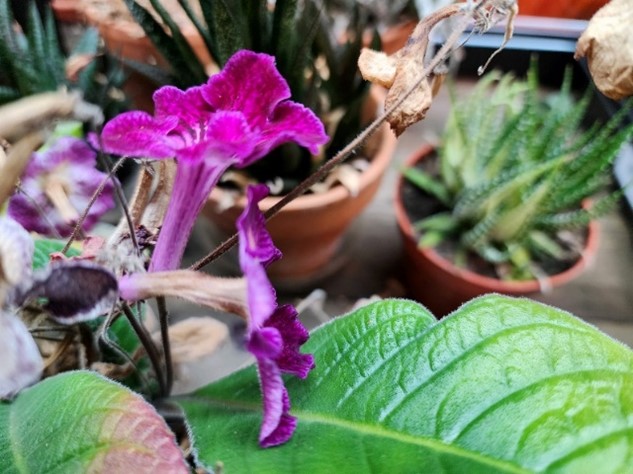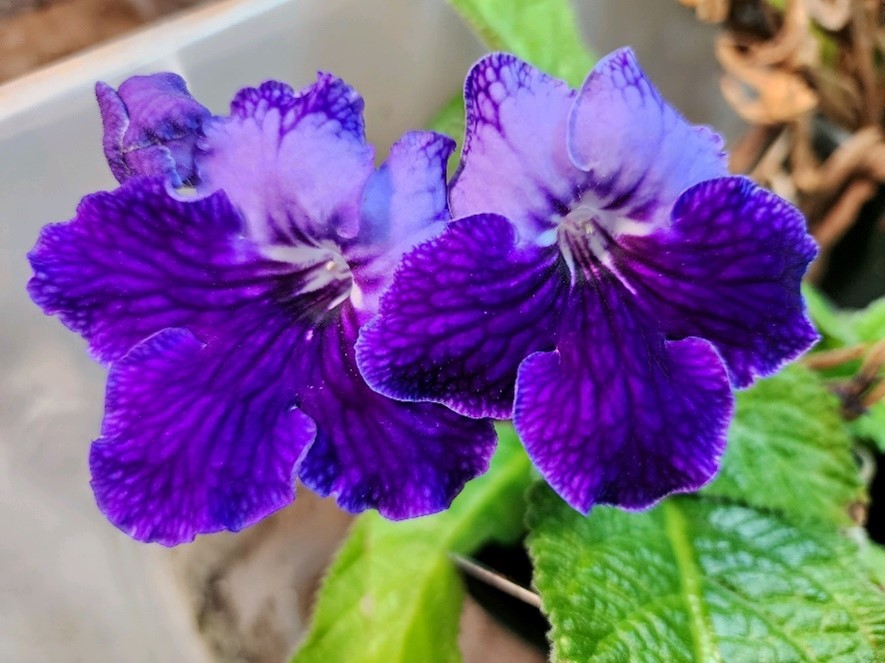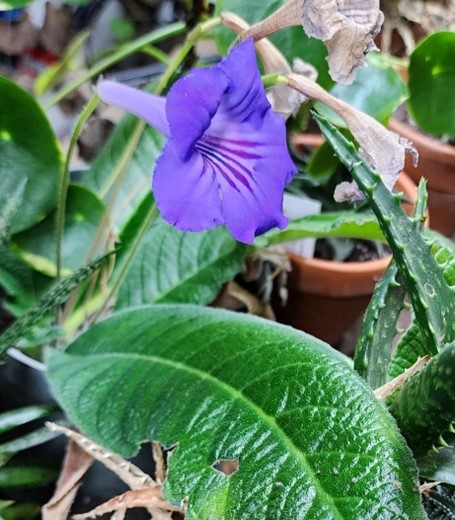If I could only have one species of houseplant, I would pick the Cape Primrose, or Streps, as they are sometimes called. These are sometimes also referred to by their full scientific name, Streptocarpus, and are usually hybrids of a few different species. Interestingly, these plants are related to the familiar African Violet and are part of a large family of plants called Gesneriads (Family: Gesneriaceae). These are all beautiful plants that are grown mostly for their exquisite blooms, but a few have exceptional foliage as well. Most of the Strep hybrids offered for sale have elongated, green leaves. I did have one variety a long time ago that actually had variegated leaves. There are pure bred species of Streptocarpus for sale if you hunt, but these have much smaller, plain flowers that pale in comparison to the hybrids.
Although the care is similar to African Violets, I find Streps to be a lot more forgiving. They are not as prone to rotting and they grow a lot faster. In general, they are probably the most hardy Gesneriad I have kept. In addition to being easier to keep, they bloom profusely in the home. Their blooms are the best part of these plants as they are much larger than the flowers on African Violets. Although the plant will frequently put up a few blooms, with proper care, the plant will send up many and make quite the display! The trumpet-shaped flowers come in just about every color you can think of, as well as bicolors. Some of my favorites have one color on the outside of the flower, and different color on the inside. Flower petals may also be ruffled, and some even have splashes of other colors on the flower, making it look like someone threw paint on them. Their colors include red, blue, purple, black, white, yellow, and various combinations. They do not need much light, and a bright window or table lamp will provide them with all that they need. They thrive under fluorescent and/or LED lighting. This allows the grower to have a large collection of them.
The only downside to Streps is that they do not like hot weather. They generally stop blooming during this time, and frequently need water. If allowed to dry too much, or with repeated drying, these plants may suffer greatly or die. But this disadvantage is also their advantage. They actually prefer cool, moist areas. In the summer, I like to put mine outside underneath a big mature tree where they thrive in the shade. Don’t forget to water them frequently in the warmer weather. They generally bloom profusely in this setting.
Over the winter, when just about everything else outside is dormant, and even our regular houseplants are trying to get to the spring, these Cape Primroses are thriving. A cool, moist basement is their ideal growing condition, provided you give them some artificial light. Many other species of houseplants do not like a cold, drafty basement and can get a fungus and die. Cape Primroses are the opposite. Mine seem to be very happy and continue to bloom throughout the winter. They do occasionally take some short breaks between large blooming events at various times of the year, but these are not too frequent.

As stated above, they are related to African Violets, and have similar cultural requirements. The planting medium should have some extra perlite added to it to improve drainage. Soggy soil is the way to kill either of these plant species. Do not let the pot sit in the water that collects in the saucer for more than a half hour or so. Let the plants dry between waterings. Streps will actually start to wilt if they get too dry but perk up with prompt watering. Do not let this happen repeatedly as this can be a terrible stress on the plant and may reduce blooming. I like to fertilize each time I water with an African Violet fertilizer per package directions.

One of the greatest joys of plant keeping is propagating them. Cape Primroses are rather easy to propagate. Simply take one of their elongated leaves and cut it into pieces. Dip one end into some rooting hormone (I prefer the powder type). Plant this shallowly in the same type of potting medium as used for the adult plants. Water well and place a small plastic bag upside down over the plant/pot to keep the humidity high as the plant does not have any roots to absorb water yet. If you are propagating a number of them, get a 1020 tray and cover it with one of the taller humidity domes. Keep the cutting watered, but not soggy. In no time, you will see new plantlets sprouting from the surface. I find these new plants to be extremely hardy. Pot up when the plant looks too big for the pot, but be careful not to rush this part. A good indicator is when the plant needs to be watered more than once a week.
Despite all of the perks to these plants, they are surprisingly hard to find. Many of our plant stores do not carry them, and I have never seen them in the big box stores. I think it is due to their lack of heat tolerance. Shipping temperatures are hard to control, and an extended period without water would be fatal. Fortunately, there are many online retailers that will ship these plants year-round. Another option, if you really like these plants, is to join a Gesneriad society or local plant group. This will allow you to trade varieties with other enthusiasts. Hopefully you are able to find some and give Cape Primroses a try!
Dr. Matt Lisy, UConn Adjunct Professor

